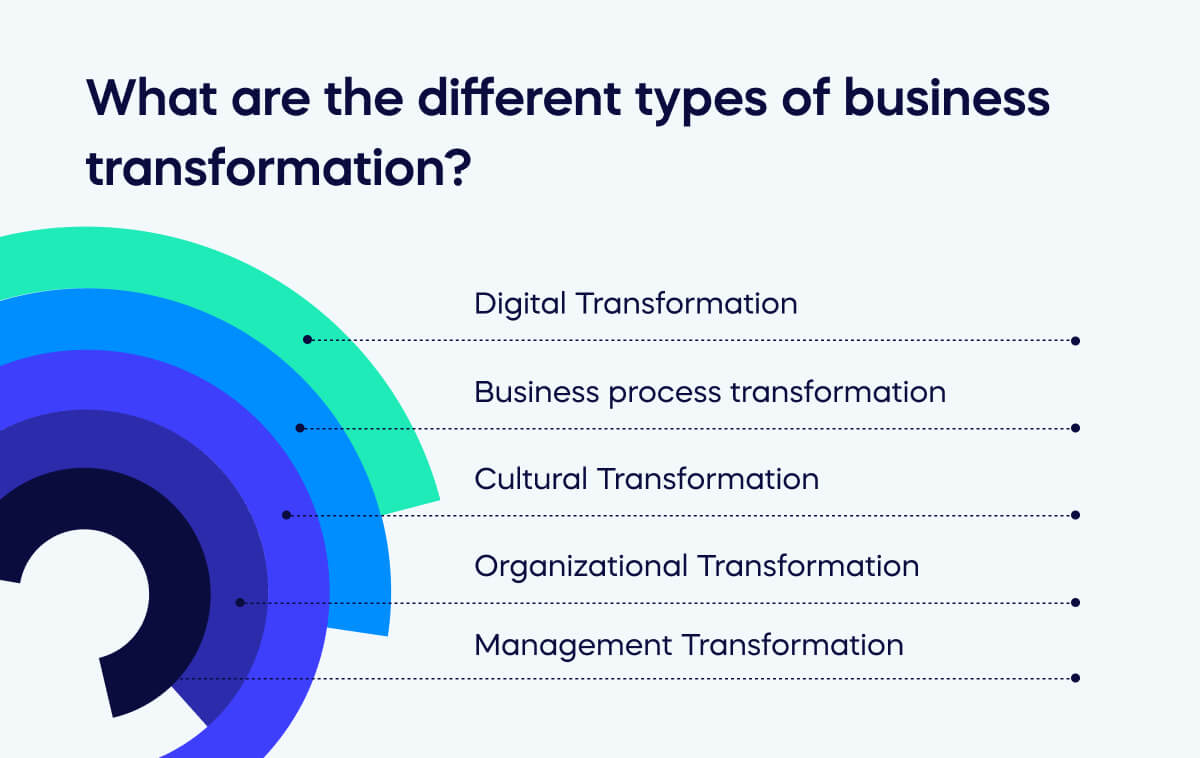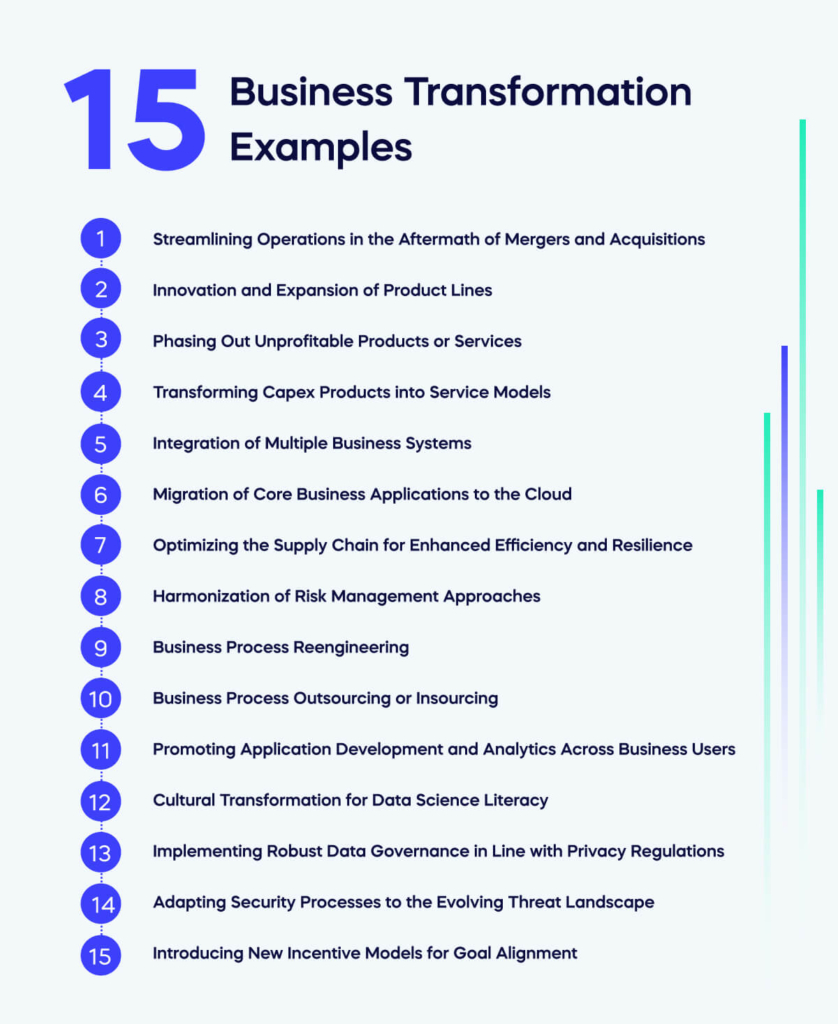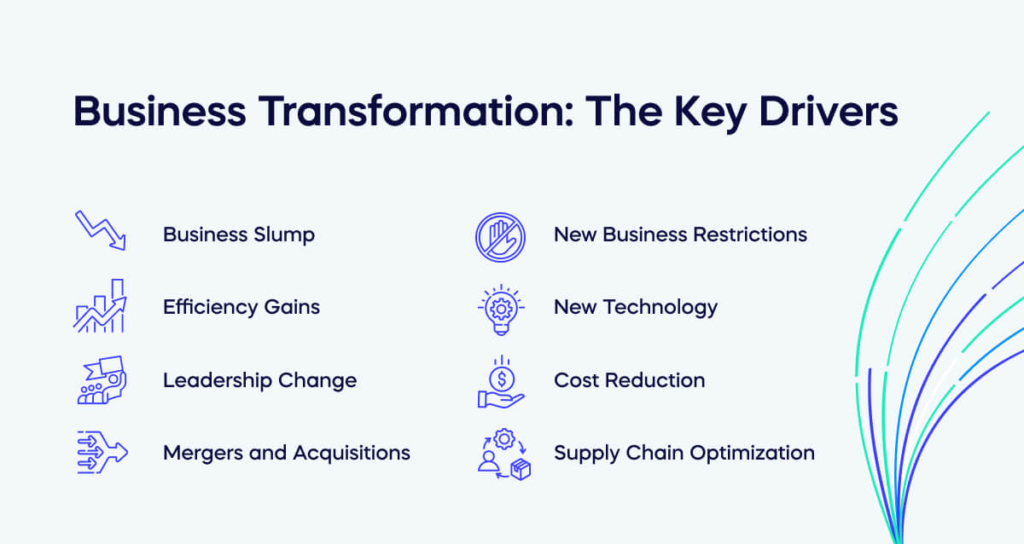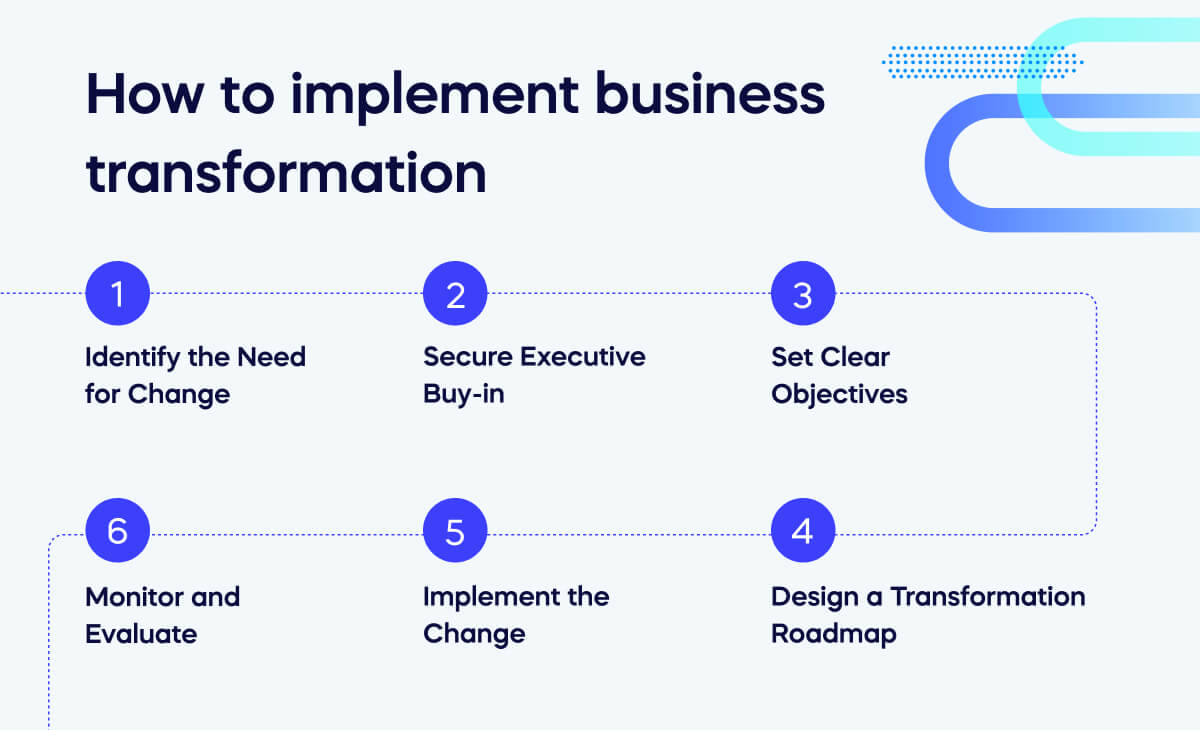What is business transformation?
Business transformation is a strategic, organization-wide change aimed at improving efficiency, productivity, and efficacy while driving growth. It entails a fundamental shift in how a business operates, often involving changes to its culture, processes, systems, and organizational structure.

Table of contents
This process might include digital transformation, leveraging technology to automate workflows, and to improve customer experiences and data-driven decision-making. It could also involve a shift to business models based on subscription services or even redesigning the business’s physical space.
Ultimately, business transformation is about adapting to changing market dynamics, staying competitive, and fulfilling evolving customer needs. It requires strong leadership, clear vision, and meticulous execution, ensuring all stakeholders are aligned toward the same goals.

You may like:
- Business Transformation: A Guide for the Digital Age
- How Can You Empower Your Business Transformation?
- Watch: Digital adoption is the key to a successful business transformation
What are the different types of business transformation?

Business transformation is an overarching term that can encompass many different types of initiatives. These include:
Digital Transformation: Digital transformation is the comprehensive integration of advanced digital technology into all operational areas of an enterprise. It aims to fundamentally alter business processes and provide superior value to customers. This process requires a profound rethinking of how an organization leverages technology, human resources, and workflows to dramatically enhance business performance.
Business process transformation: Business process transformation is a type of transformation that emphasizes changing how things get done and how tasks are completed. It can involve optimization and automation of repetitive processes. A digital adoption platform can be instrumental in streamlining processes and used as a tool to continuously alleviate unnecessary and cumbersome tasks. Eliminating repetitive tasks or processes gives organizations extra time and resources to be more innovative and productive.
Cultural Transformation: Cultural transformation is altering the intrinsic beliefs, values, and attitudes of individuals within an organization. It signifies a fundamental shift in employees’ thought processes, behavior patterns, and work ethics. This requires changes to existing corporate values, leadership styles, decision-making processes, and organizational structure.
Organizational Transformation: Organizational transformation denotes a sweeping change in the structure or strategy of an organization. It can encompass modifying the organization’s mission, restructuring operations, adopting new technologies, mergers, significant collaborations, downsizing, or implementing programs such as Total Quality Management or re-engineering.
Management Transformation: Management transformation pertains to changing the managerial approach within an organization. This could represent transitioning from a conventional, hierarchical management structure to a more horizontal, agile management method. It entails empowering employees with decision-making authority, promoting collaboration and innovation, and delegating tasks while enabling team autonomy.
Management Transformation in a Nutshell:
- Management transformation is triggered by a paradigm shift in leaders’ mindsets. This could involve adopting a servant leadership style, fostering a growth mindset, or encouraging an environment of psychological safety.
- It involves altering management practices and processes, including implementing agile methodologies, lean management practices, or incorporating a balanced scorecard approach.
- The transformation often necessitates upskilling or reskilling managers, requiring comprehensive training programs focusing on emotional intelligence, conflict resolution, strategic thinking, and other relevant competencies.
- It calls for a commitment to continuous improvement and learning, instilling a culture of regular feedback, learning from failures, and embracing change.
15 Business Transformation Examples

Business transformation initiatives encompass fundamental changes that require effective change management. These initiatives may include the following:
- Streamlining Operations in the Aftermath of Mergers and Acquisitions: Post-merger or acquisition, it’s pivotal to amalgamate the operations of both entities. This involves harmonizing processes, integrating teams, and eliminating redundancies to create a unified, efficient entity.
- Innovation and Expansion of Product Lines: To remain competitive, businesses should constantly innovate and expand outside their traditional scope. This could mean developing new products that complement their existing offerings, thereby diversifying their portfolio and reaching new markets.
- Phasing Out Unprofitable Products or Services: Companies must regularly audit their product lines or services. If certain offerings are consistently underperforming or no longer align with the company’s strategic direction, it may be time to discontinue them.
- Transforming Capex Products into Service Models: In the digital age, many businesses are transitioning from capital expenditure (Capex) products to offering similar functionalities as-a-service. This approach can provide more flexibility, scalability, and cost-effectiveness for customers.
- Integration of Multiple Business Systems: Businesses should consider consolidating their disparate systems into a single, integrated platform to enhance efficiency. This can streamline workflows, improve data consistency, and reduce operational complexities.
- Migration of Core Business Applications to the Cloud: Cloud technology offers numerous benefits, including scalability, flexibility, and cost savings. By migrating core business applications to the cloud, companies can leverage these advantages while staying current with technological advancements.
- Optimizing the Supply Chain for Enhanced Efficiency and Resilience: Streamlining supply chain processes can significantly improve efficiency and resilience. This could involve adopting lean methodologies, implementing advanced analytics, or leveraging technologies like AI and IoT.
- Harmonization of Risk Management Approaches: By consolidating various risk management strategies into a single group, businesses can maintain a more comprehensive and cohesive view of their risk landscape, leading to more effective mitigation strategies.
- Business Process Reengineering: This involves radically redesigning core business processes to substantially improve productivity, cycle times, and quality. It’s a strategic decision that can lead to significant competitive advantages.
- Business Process Outsourcing or Insourcing: Depending on the company’s strategy, resources, and capabilities, it may outsource certain business processes or insource previously outsourced tasks. This can help optimize resource allocation, control costs, and focus on core competencies.
- Promoting Application Development and Analytics Across Business Users: By democratizing these skills, employees at all levels can contribute to innovation and decision-making processes, fostering a culture of continuous improvement and growth.
- Cultural Transformation for Data Science Literacy: As data becomes increasingly crucial in decision-making, companies need to foster a culture where every employee understands and appreciates the value of data science, enhancing overall business intelligence.
- Implementing Robust Data Governance in Line with Privacy Regulations: With the growing importance of data privacy, businesses need to adopt robust data governance policies that comply with evolving regulations, ensuring they protect customer data and maintain trust.
- Adapting Security Processes to the Evolving Threat Landscape: As cyber threats become more sophisticated, businesses must continually update their security processes. This may involve adopting new technologies, training employees, or partnering with cybersecurity experts.
- Introducing New Incentive Models for Goal Alignment: To ensure employees’ objectives align with the company’s strategic goals, businesses can introduce new incentive models. These could include performance-based bonuses, profit-sharing schemes, or non-monetary rewards.
Business Transformation: The Key Drivers

Business transformation is a change management strategy that involves aligning people, processes, and technology with the company’s strategic goals.
This process often involves a significant shift in how a company operates, which can be driven by several factors. Here are eight key drivers of business transformation:
- Business Slump: A decline in business performance is a clear sign that something isn’t working and is often a catalyst for transformation. Whether it’s a drop in sales, decreased customer satisfaction, or increased costs, a business slump can be a wake-up call for companies to reevaluate their operations and implement necessary changes.
- Efficiency Gains: In an era where time is money, efficiency gains are a significant driver for business transformation. By streamlining processes and eliminating redundancies, companies can save time and resources. This could involve reengineering workflows, adopting new technologies, or restructuring teams to ensure tasks are executed more efficiently.
- Leadership Change: When new leadership enters a company, it can lead to a significant shift in direction. New leaders bring fresh perspectives, strategies, and objectives, which can drive business transformation. They may see opportunities for improvement that previous leaders overlooked or were hesitant to pursue.
- Mergers and Acquisitions: Mergers and acquisitions often necessitate business transformation as the combined entity needs to integrate processes, systems, and cultures. This integration can require substantial changes to achieve synergies and ensure the newly formed organization operates smoothly and effectively.
- New Business Restrictions: Changes in regulations or industry standards can force companies to transform their operations to remain compliant. These new restrictions can impact everything from product development to marketing strategies, requiring businesses to adapt quickly or face potential penalties.
- New Technology: The advent of new technology is a powerful driver for business transformation. Whether cloud computing, artificial intelligence, or blockchain, these technologies can revolutionize a company’s operations. Adopting new technology can improve efficiency, enhance customer experience, and open up new business opportunities.
- Cost Reduction: Cost reduction is a common driver for business transformation. By finding ways to reduce expenses, companies can increase their profitability without necessarily increasing their revenue. This can involve anything from renegotiating contracts with suppliers to implementing energy-saving measures.
- Supply Chain Optimization: In the wake of global disruptions like the “next normal” created by the COVID-19 pandemic, many companies are looking to transform their supply chains to make them more resilient. This transformation can involve diversifying suppliers, investing in technology to improve visibility, or even reshoring production to reduce dependence on foreign suppliers.
How to implement business transformation

Embracing change is an essential part of business growth and sustainability. While a complex process, business transformation can revolutionize your organization’s operations, culture, and overall performance.
This section will guide you through the critical steps involved in implementing successful business transformation, from identifying the need for change to measuring the impact of your new processes:
- Identify the Need for Change: Recognize that a change within your organization is necessary. This could be due to shifts in market trends, customer behavior, competitive pressure, or internal factors such as operational inefficiencies. Conduct a thorough analysis of your business to pinpoint areas that need improvement.
- Secure Executive Buy-in: To successfully implement transformation, you need the support and commitment of your organization’s leadership. Present your case to the executive team, highlighting how the proposed changes align with the company’s strategic goals and the benefits they will bring. Their buy-in is crucial as it can help overcome resistance to change and provide the resources necessary for implementation.
- Set Clear Objectives: Set specific objectives that you aim to achieve with this transformation. This could be improving customer satisfaction, increasing operational efficiency, or fostering innovation. Ensure these objectives align with your company’s overarching strategy and vision.
- Design a Transformation Roadmap: Create a detailed plan outlining the steps to attain these goals. Include timelines, milestones, resource allocation, potential risks, and mitigation strategies. Specify the responsibilities for each task.
- Implement the Change: Execute the plan, which may involve restructuring teams, adopting new technologies, altering business processes, or even reshaping your company culture. Communication is key during this phase. Keep all stakeholders informed about the progress and any changes to the plan.
- Monitor and Evaluate: After implementation, monitor the impact and evaluate the effectiveness of the transformation. Use KPIs and metrics that align with your objectives to track progress. Be ready to make adjustments to your plan based on these evaluations.
Remember that business transformation is a continuous cycle, not a one-time event. Constant reassessment and adaptation of your strategy are necessary to stay relevant and competitive.
Business Transformation Best Practises
Undertaking a business metamorphosis is paramount for organizations aspiring to acclimatize and flourish in the perpetually evolving digital terrain of the modern world. This process necessitates a calculated methodology to augment business procedures, competencies, and operational efficacy.
Here are some best practices based on the sources mentioned above:
Firstly, it’s crucial to evaluate the existing business situation. This involves understanding the organization’s problem, assessing current performance, and identifying areas that require improvement or adaptation. A clear understanding of the business situation helps define the transformation’s focus.
Secondly, getting executive and employee buy-in is vital. Leadership must support transformation initiatives to align with the overall business strategy. Additionally, engaging employees in daily conversations promotes openness and collaboration, which are essential for successful transformation.
Business transformation best practices involve a combination of strategic planning, leadership buy-in, appropriate technology selection, and effective execution and integration. When executed correctly, these practices can lead to a successful transformation that boosts business efficiency and competitiveness.
You may like:
- Business Transformation: A Guide for the Digital Age
- How Can You Empower Your Business Transformation?
- Watch: Digital adoption is the key to a successful business transformation